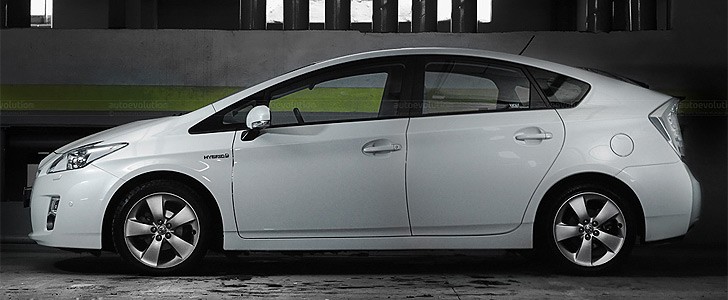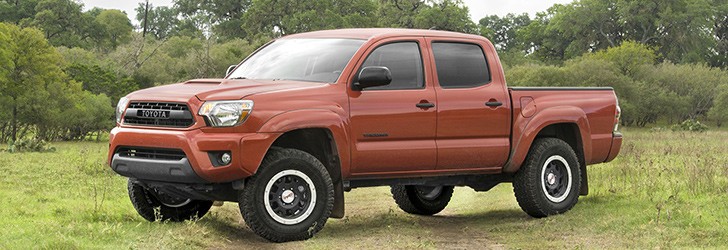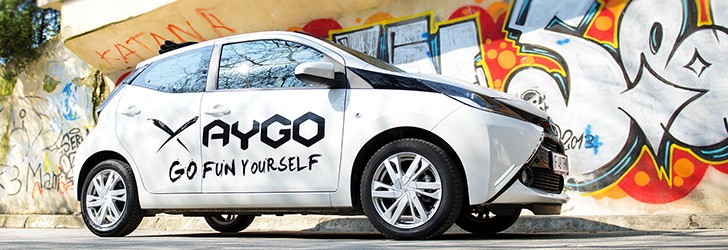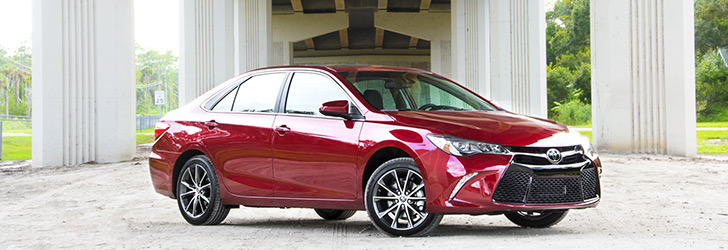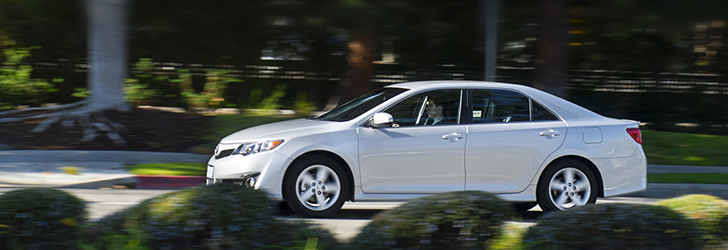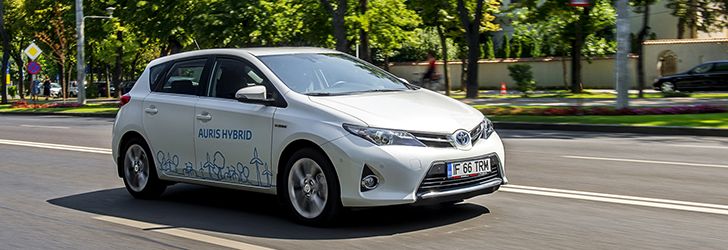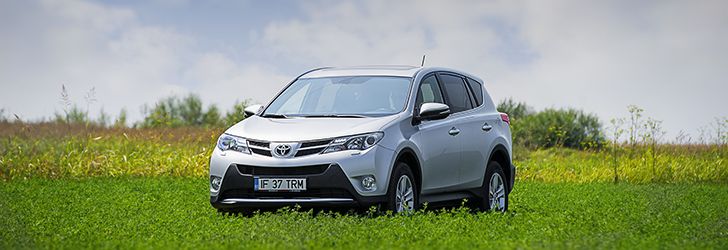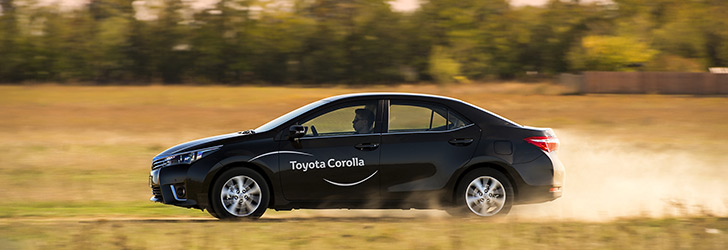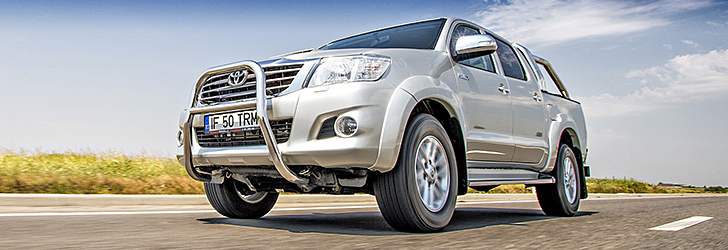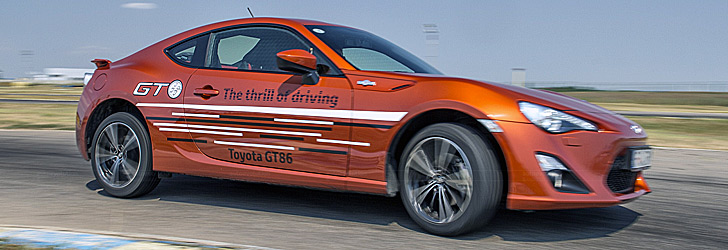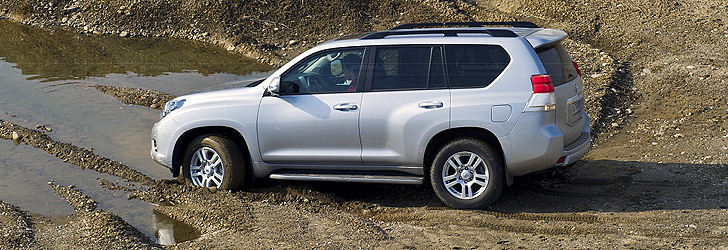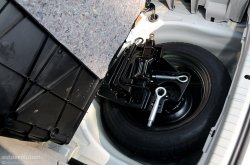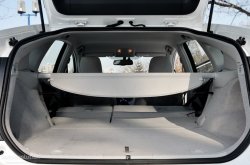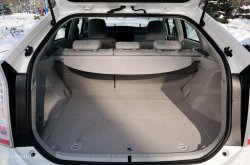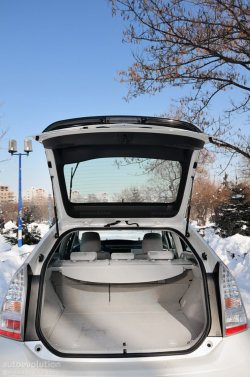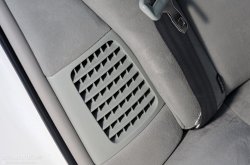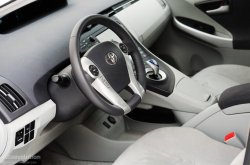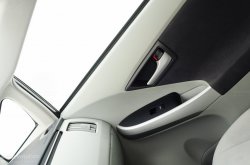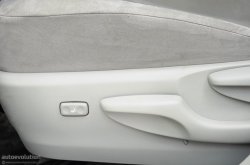TOYOTA Prius Review
OUR TEST CAR: Toyota Prius Hybrid
The overall comfort while driving a Prius isn't exactly spectacular, but it's not an ox-driven cart either. The suspension setup is a very good compromise between a rather sporty feel during more "dynamic" driving and the somewhat plush feel of any mid-size Toyota. The only thing that could prevent the well being of the passengers from the suspension comfort point of view would probably be the 17-inch wheels with low tire walls.
As for the seating comfort, there are numerous manual controls for the front passenger seats so even the most pretentious ones can feel just fine. There's not a lot of side support but then again, there's no way anyone would buy a Prius to drive it like a maniac. The rear seats are comfy enough, while the overall room available is enough for four or even five adults, as long as the ones sitting in the rear aren't very tall.
The creature comforts for the model we tested aren't over the top, especially when considering the drivetrain's technology level, but the basic necessities were present. Stuff like a very effective single-zone automatic climate control or electrically-controlled lumbar support on the front seats were available, but there was also something that we didn't actually understand and that might prove to be a downside if the car has to fit five persons for a longer ride.
On the right side of the rear seats, near the side bolster there's a cooling duct, that apparently uses air from the car's interior to cool the batteries. In the car's manual it was specified that under no circumstance that cooling duct should be blocked by a passenger or luggage, since it might cause a malfunction on the car's battery cooling system. Strange but true, especially since there's a very high chance that someone might actually sit on it and cover it on a longer drive. Other than that, the Prius actually feels like a well made mid-size compact car that offers quite a bit above the minimum comfort for its passengers.
The best bit about using an Atkinson-cycle engine in a car is the fact that it's much more efficient, therefore it uses much less fuel than a regular Otto-cycle. Of course, what many people don't know is that the Toyota Prius, along with pretty much all the other hybrid cars out there, is not using a true Atkinson-cycle IC engine, but one that is more closely connected to a Miller-cycle like in some old-school Mazdas, without being supercharged or turbocharged though.
What makes us say this is the fact that the 1.8-liter four-cylinder under the Prius' hood is not using different power and compression strokes, like in the original Atkinson engine, but becomes more efficient by adding a so-called "fifth stroke". More specific, in the "Prius Atkinson-cycle", the intake valve is held open longer than normal to allow a reverse flow of intake air into the intake manifold. This translates into a compression ratio that is smaller than the expansion ratio, therefore the engine uses less fuel but also makes less power.
In total, there are three engines and a pretty compact (compared to its predecessors) stack of NiMh batteries in the Prius. The aforementioned Atkinson-cycle 1.8-liter is used to power the driving wheels and/or recharge the batteries via one of the electric engines. One of the electric engines is used to either power the driving wheels when the batteries have enough juice or to recharge the batteries by using electricity from the regenerative braking system or from the ICE.
The second electric motor is actually the most interesting bit about this whole ensemble. Believe it or not, the Prius - just like all Toyotas that use the Hybrid Synergy Drive system – doesn't have a transmission, or at least not in the regular sense you all know. The second electric motor is actually the "transmission", acting pretty much in the same way as a CVT (Continuous Variable Transmission). That is also probably the reason why Toyota brochures always mention its hybrids to have an "eCVT".
In other words, there is no direct mechanical connection between either the internal combustion engine or the second electric motor and the wheels. Both engines transmit their power via another computer-controlled electric motor, which varies the input/output ratio just like an average Continuous Variable Transmission. All in all, the Prius takes so many automotive breakthroughs for granted it's not even funny.
Considering we tested the mid-range trim level of the European Prius, there were some gadgets missing from the top of the line version, but that doesn't mean the ones included weren't more than enough. For example, we didn't get to test how good the intelligent sunroof works, since that is only available for the most expensive Prius out there.
Why do we call it intelligent? Well, for the top of the line version there is a sunroof which includes a solar-powered ventilation system for when the car is stationary. Apparently, the original solar-powered system should have been used to additionally power the Prius' battery, but the Japanese engineers discovered that that configuration was causing electromagnetic interference that affected the radio.
Anyway, as we mentioned, we didn't have that system on the car we drove so we can't talk about it much. We did have the high-tech head-up display though, which is especially helpful for the drivers who never look at the dashboard while driving. Other than that, our test car was also fitted with a strange bi-xenon-like HID headlight system equipped with a light sensor. We call it strange because it wasn't exactly a true bi-xenon system, since both headlights on each side were only used for the low-beam.
The hi-fi audio system and the HDD-based navigation system were both using a touchscreen display that was beautifully-integrated in the swooping center console in a pretty ergonomic position. Other than the four electrically-operated windows with an automatic feature and the cruise control system, the most impressive gadget was probably the car itself, or better yet, its drivetrain. We say this because the Prius incorporates some of the most modern technologies currently available for a self-propelled car.
Just like its main nemesis on the American market, the Honda Insight, the Prius achieved best in class ratings at the NHTSA crash tests and the Top Safety Pick award from the IIHS. After also being tested by the European NCAP, it scored five stars with a close to maximum rating for each chapter of the tests.
The hypochondriacs among Prius' potential customers might of course say that those controlled crash tests ratings mean almost nothing in the real world, but Toyota's brochure is close at hand to relieve them of their worries. In standard, the Prius comes with two dual-stage airbags, a driver knee airbag, two side airbags for the front passengers and two head airbags that protect both the front occupants and the rear ones.
As for the active safety features present on the car, the Prius also comes with an anti-lock braking system, a traction control system and an non-switchable (why would you turn it off in a Prius?) stability control system. Sure, a bunch of Prius models are currently recalled for some braking issues, bot none of them has proved to be life-threatening so far, so the main fact remains: the Toyota Prius is a safe car.
Since this was the first time we drove a Toyota Prius, we didn't know much what to expect from it, except for the usual "it's politically correct","it's green", "it's slow", etc. What we found out after testing it is probably the fact that it's very "niche". The best thing we liked about it, apart from all the bells and whistles of the technology incorporated in it, is obviously the low fuel consumption and the fact that you can actually drive it not using a single drop of fuel for a small distance.
Its main disadvantage is probably the fact that it no longer feels like an old-school car, but just a very effective means of personal transportation. To some of us here at autoevolution, the Prius is nothing but a high-tech appliance with absolutely no soul. Not to say that your average cost-effective Korean econobox has more soul than this, but the Prius can probably only be truly loved by people who hate cars or who downgrade them to the point of necessary evils.
The ugly bit about the Prius is probably its design. Not in the literal sense, since it does have some really nice design cues from some angles, but in the sense that it truly stands out as a hybrid, or green "hippie car" on the road. Some people like that and only buy hybrids to achieve a certain status. The others, who only want fuel economy without having to be in the spotlight for it are probably better left with either a green diesel or a "regular" car converted to be a hybrid.
As for the seating comfort, there are numerous manual controls for the front passenger seats so even the most pretentious ones can feel just fine. There's not a lot of side support but then again, there's no way anyone would buy a Prius to drive it like a maniac. The rear seats are comfy enough, while the overall room available is enough for four or even five adults, as long as the ones sitting in the rear aren't very tall.
The creature comforts for the model we tested aren't over the top, especially when considering the drivetrain's technology level, but the basic necessities were present. Stuff like a very effective single-zone automatic climate control or electrically-controlled lumbar support on the front seats were available, but there was also something that we didn't actually understand and that might prove to be a downside if the car has to fit five persons for a longer ride.
On the right side of the rear seats, near the side bolster there's a cooling duct, that apparently uses air from the car's interior to cool the batteries. In the car's manual it was specified that under no circumstance that cooling duct should be blocked by a passenger or luggage, since it might cause a malfunction on the car's battery cooling system. Strange but true, especially since there's a very high chance that someone might actually sit on it and cover it on a longer drive. Other than that, the Prius actually feels like a well made mid-size compact car that offers quite a bit above the minimum comfort for its passengers.
The best bit about using an Atkinson-cycle engine in a car is the fact that it's much more efficient, therefore it uses much less fuel than a regular Otto-cycle. Of course, what many people don't know is that the Toyota Prius, along with pretty much all the other hybrid cars out there, is not using a true Atkinson-cycle IC engine, but one that is more closely connected to a Miller-cycle like in some old-school Mazdas, without being supercharged or turbocharged though.
What makes us say this is the fact that the 1.8-liter four-cylinder under the Prius' hood is not using different power and compression strokes, like in the original Atkinson engine, but becomes more efficient by adding a so-called "fifth stroke". More specific, in the "Prius Atkinson-cycle", the intake valve is held open longer than normal to allow a reverse flow of intake air into the intake manifold. This translates into a compression ratio that is smaller than the expansion ratio, therefore the engine uses less fuel but also makes less power.
In total, there are three engines and a pretty compact (compared to its predecessors) stack of NiMh batteries in the Prius. The aforementioned Atkinson-cycle 1.8-liter is used to power the driving wheels and/or recharge the batteries via one of the electric engines. One of the electric engines is used to either power the driving wheels when the batteries have enough juice or to recharge the batteries by using electricity from the regenerative braking system or from the ICE.
The second electric motor is actually the most interesting bit about this whole ensemble. Believe it or not, the Prius - just like all Toyotas that use the Hybrid Synergy Drive system – doesn't have a transmission, or at least not in the regular sense you all know. The second electric motor is actually the "transmission", acting pretty much in the same way as a CVT (Continuous Variable Transmission). That is also probably the reason why Toyota brochures always mention its hybrids to have an "eCVT".
In other words, there is no direct mechanical connection between either the internal combustion engine or the second electric motor and the wheels. Both engines transmit their power via another computer-controlled electric motor, which varies the input/output ratio just like an average Continuous Variable Transmission. All in all, the Prius takes so many automotive breakthroughs for granted it's not even funny.
Considering we tested the mid-range trim level of the European Prius, there were some gadgets missing from the top of the line version, but that doesn't mean the ones included weren't more than enough. For example, we didn't get to test how good the intelligent sunroof works, since that is only available for the most expensive Prius out there.
Why do we call it intelligent? Well, for the top of the line version there is a sunroof which includes a solar-powered ventilation system for when the car is stationary. Apparently, the original solar-powered system should have been used to additionally power the Prius' battery, but the Japanese engineers discovered that that configuration was causing electromagnetic interference that affected the radio.
Anyway, as we mentioned, we didn't have that system on the car we drove so we can't talk about it much. We did have the high-tech head-up display though, which is especially helpful for the drivers who never look at the dashboard while driving. Other than that, our test car was also fitted with a strange bi-xenon-like HID headlight system equipped with a light sensor. We call it strange because it wasn't exactly a true bi-xenon system, since both headlights on each side were only used for the low-beam.
The hi-fi audio system and the HDD-based navigation system were both using a touchscreen display that was beautifully-integrated in the swooping center console in a pretty ergonomic position. Other than the four electrically-operated windows with an automatic feature and the cruise control system, the most impressive gadget was probably the car itself, or better yet, its drivetrain. We say this because the Prius incorporates some of the most modern technologies currently available for a self-propelled car.
Just like its main nemesis on the American market, the Honda Insight, the Prius achieved best in class ratings at the NHTSA crash tests and the Top Safety Pick award from the IIHS. After also being tested by the European NCAP, it scored five stars with a close to maximum rating for each chapter of the tests.
The hypochondriacs among Prius' potential customers might of course say that those controlled crash tests ratings mean almost nothing in the real world, but Toyota's brochure is close at hand to relieve them of their worries. In standard, the Prius comes with two dual-stage airbags, a driver knee airbag, two side airbags for the front passengers and two head airbags that protect both the front occupants and the rear ones.
As for the active safety features present on the car, the Prius also comes with an anti-lock braking system, a traction control system and an non-switchable (why would you turn it off in a Prius?) stability control system. Sure, a bunch of Prius models are currently recalled for some braking issues, bot none of them has proved to be life-threatening so far, so the main fact remains: the Toyota Prius is a safe car.
Since this was the first time we drove a Toyota Prius, we didn't know much what to expect from it, except for the usual "it's politically correct","it's green", "it's slow", etc. What we found out after testing it is probably the fact that it's very "niche". The best thing we liked about it, apart from all the bells and whistles of the technology incorporated in it, is obviously the low fuel consumption and the fact that you can actually drive it not using a single drop of fuel for a small distance.
Its main disadvantage is probably the fact that it no longer feels like an old-school car, but just a very effective means of personal transportation. To some of us here at autoevolution, the Prius is nothing but a high-tech appliance with absolutely no soul. Not to say that your average cost-effective Korean econobox has more soul than this, but the Prius can probably only be truly loved by people who hate cars or who downgrade them to the point of necessary evils.
The ugly bit about the Prius is probably its design. Not in the literal sense, since it does have some really nice design cues from some angles, but in the sense that it truly stands out as a hybrid, or green "hippie car" on the road. Some people like that and only buy hybrids to achieve a certain status. The others, who only want fuel economy without having to be in the spotlight for it are probably better left with either a green diesel or a "regular" car converted to be a hybrid.
THE END
12
Our TOYOTA Testdrives:
Photo gallery (68)
